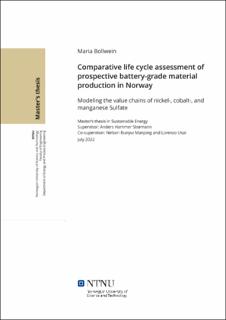| dc.description.abstract | The manufacturing of battery grade materials is electricity intensive and currently
dominated by China. Several European countries are exploring options of
venturing into locally produced raw materials for battery manufacturing. In
Norway, four battery manufacturing facilities are planned or under construction
which increases the need for locally manufactured battery grade materials. This
study investigates the potential impacts of producing nickel, cobalt and manganese
sulfate in Norway, a country known for its renewable-sourced electricity. A high
resolution model is developed for each of the three battery grade materials which
considers individual steps of the value chain from mining to the final product.
This is vital in the modelling as some processes, especially those pertaining to
mining and ore processing occur outside of Norway. Environmental impacts of
these battery grade materials are performed with Arda, an in house LCA calculator
using ReCiPe2016 as midpoint characterization method.
The results show that, producing nickel and cobalt sulfate in Norway yields 3.3kg
CO2eq. and 7.7kg CO2eq., respectively, with the highest contribution from ore
processing which occurs in Canada. Manganese sulfate produced in Norway
with ores mined in Gabon causes a GWP of 1.3 kgCO2eq., mainly due to metal
refining impacts. The results are benchmarked with other studies performed
across different geographical system boundaries to depict the emission reduction
opportunities in producing these battery grade materials in Norway. What is
observed is that, production of these sulfates in Norway has significant emission
reduction benefits as compared to other studies reported in the scientific literature.
To increase the robustness of the analysis, the thesis further develops scenarios
to investigate the effect of changes in the electricity mix intensity of different
mining and production countries on the overall GWP. Within these scenarios, the
Norwegian case still emerges with the lowest GWP. Results of this study indicate
that producing battery grade materials in Norway has prospects of reducing the
emissions associated with cell materials in lithium-ion batteries. Furthermore,
from the scenarios developed, the GWP of cathode precursors can be significantly
reduced by using low carbon electricity in both mining and producing countries. | |
